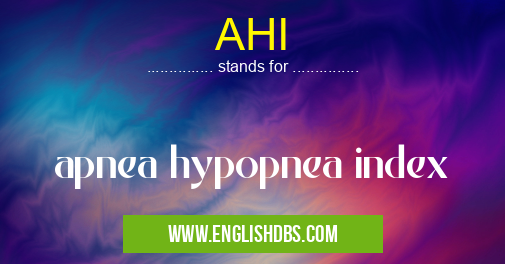What does AHI mean in MEDICAL
The Apnea Hypopnea Index, or AHI for short, is a measure of the severity of sleep apnea and other forms of breathing disturbances during sleep. It is derived from the number of apneas and hypopneas, or pauses in breathing, that occur during a set amount of time spent sleeping. Calculating an individual's AHI helps to accurately diagnose and identify the type and degree of sleep-disordered breathing they may have.

AHI meaning in Medical in Medical
AHI mostly used in an acronym Medical in Category Medical that means apnea hypopnea index
Shorthand: AHI,
Full Form: apnea hypopnea index
For more information of "apnea hypopnea index", see the section below.
What is AHI?
AHI is a number calculated by measuring the frequency of apneas (pauses in breathing lasting 10 seconds or more) and hypopneas (shallow breaths lasting 10 seconds or more), typically over a period of one hour while sleeping. An AHI score can range anywhere from 0 to 30 (zero being no apneic events and 30 being an average of 30 apneic/hypoapneic episodes per hour). The higher the score, the more severe a person's sleep disordered breathing is.
How it's used
AHI scores are used to help diagnose and treat patients with sleep disorders such as obstructive sleep apnea (OSA). This score can also be used to monitor treatment progress over time. Generally speaking, if a patient has an AHI greater than five, this indicates some form of disordered breathing during sleep requiring further evaluation and potentially treatment. If a patient's AHI remains above five after receiving treatment, their healthcare provider may need to adjust their therapy or consider additional interventions for better symptom control.
Essential Questions and Answers on apnea hypopnea index in "MEDICAL»MEDICAL"
What is the Apnea Hypopnea Index (AHI)?
The Apnea Hypopnea Index (AHI) is a measure of sleep apnea severity. It is calculated based on the total number of events per hour, including apneas (cessation of breathing) and hypopneas (breathing that is shallow or decreased due to muscle relaxation). A score of 5-15 indicates mild sleep apnea, 15-30 indicates moderate sleep apnea and more than 30 indicates severe sleep apnea.
How is the AHI calculated?
To calculate the AHI, medical professionals analyze a patient's sleep study, which uses either polysomnography or an oximetry device. Polysomnography measures and records different body functions such as brain waves, oxygen levels, heart rate and respiratory effort while the patient sleeps. Oximetry devices measure pulse oximetry readings during sleep. The data collected is then analyzed to determine how many episodes of apneas or hypopneas occur in an hour. The total events per hour are then multiplied by 60 minutes to calculate the AHI score.
What factors can influence my AHI score?
Your age, body weight and lifestyle may all factor into your AHI score. For example, people who are overweight tend to be at greater risk for developing obstructive sleep apnea. Also, people who drink alcohol before bed may have more episodes of apneas or hypopneas that could increase their AHI score.
Why is it important to know my AHI score?
Knowing your AHI score can help you make informed decisions about your health care. For example, if you have mild sleep apnea with an AHI score between 5-15, your doctor might suggest lifestyle changes such as avoiding late night snacks or drinking alcohol before bed to help reduce your symptoms. Knowing this information can help you better manage your condition and lead a healthier life overall.
What other tests may be used along with the AHI test?
In addition to measuring your AHI using polysomnography or oximetry readings during a single night's sleep study, further testing may also be conducted depending on the results of initial testing. Tests such as overnight oxygen saturation monitoring or multiple nights' sleep studies can provide additional information about a patient's condition that can be used to make more complete diagnoses and create personalized treatment plans for patients with specific conditions related to their particular case of obstructive sleep apnea disorder (OSAD).
Are there any treatments available for OSAD related issues detected by a high AHI?
Yes! Depending upon its severity level, there are several possible treatments available for OSAD related issues detected via high scores on the Apnesa Hypopnea Index test (AHI). These treatments range from conservative methods like weight loss through dietary modifications and lifestyle changes; minor surgeries intended to open up blocked airways; CPAP therapy involving continual positive airway pressure machines; oral appliances worn over teeth during sleeping hours; surgery to remove excess tissue causing obstruction in air passages; and possibly even implantable devices like pacemakers that stimulate breathing muscles while asleep.
Are there any long-term health risks I should consider if I have OSAD despite being treated?
While effective treatment for OSAD will likely reduce symptoms associated with both short-term health risks such as snoring, daytime drowsiness/ fatigue & difficulty concentrating; as well as long-term health risks like increased blood pressure & stroke risk—it's important for those afflicted with recurrent cases of OSAD take note & practice preventative care habits in order minimize relapses & unexpected exacerbations that carry potential serious side effects.
Final Words:
In summary, AHI stands for Apnea Hypopnea Index which calculates the severity of sleep disordered breathing by measuring the frequency of apneas and hypopneas over one hour while sleeping. This score can provide important information that can be used to diagnose and treat sleep disorders such as OSA as well as monitoring treatment progress over time.
AHI also stands for: |
|
| All stands for AHI |
